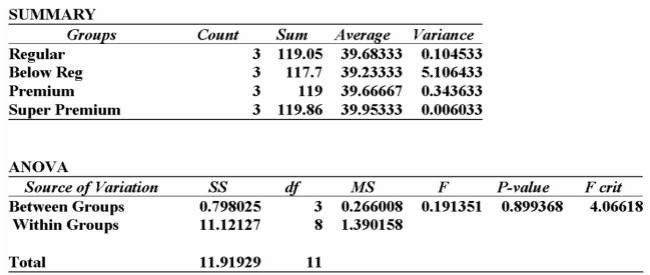Multiple Choice
Suppose that an automobile manufacturer designed a radically new lightweight engine and wants
To recommend the grade of gasoline to use. The four grades are: below regular, regular, premium,
And super premium. The test car made three trial runs on the test track using each of the four
Grades. Is there a difference in the performance between the four grades of gas? 
Using the printout given by Excel, what to you conclude? 
A) Since the calculated F-value is smaller than the F-critical value, there is a difference in the performance of these four grades of gas.
B) Since the calculated F-value is smaller than the F-critical value, there is no significant difference in the performance of these four grades of gas.
C) Since the calculated F-value is larger than the F-critical value, there is no significant difference in the performance in the four grades of gas.
D) There is no significant difference in the performance of these four grades of gas as indicated by the calculated F-value being smaller than the F-critical value, and the P-value
Correct Answer:

Verified
Correct Answer:
Verified
Q60: An F-statistic is _.<br>A)a ratio of two
Q71: Which of the following are characteristics of
Q93: i. To employ ANOVA, the populations should
Q94: i. For the population means, the alternate
Q95: A manufacturer of automobile transmissions uses three
Q96: In a study of low tar cigarettes,
Q97: The F test statistic is the ratio
Q98: Two accounting professors decided to compare the
Q99: Suppose a package delivery company purchased 14
Q100: i. One characteristic of the F distribution